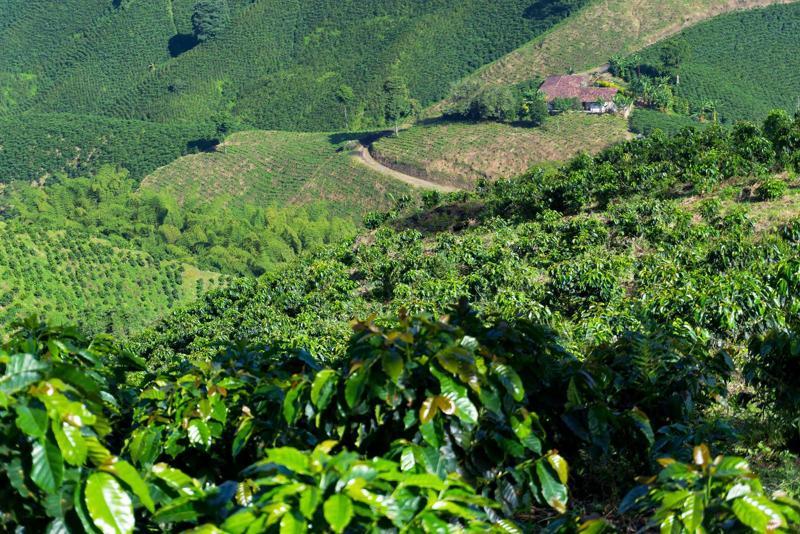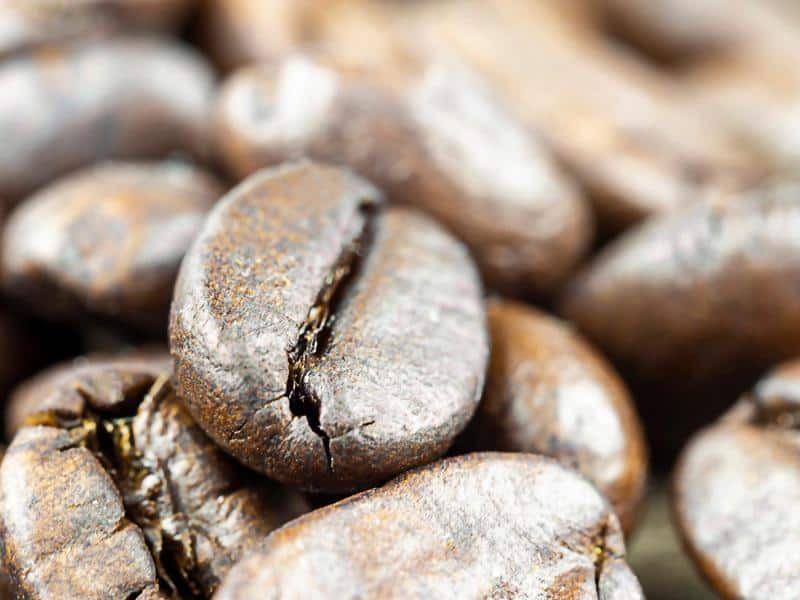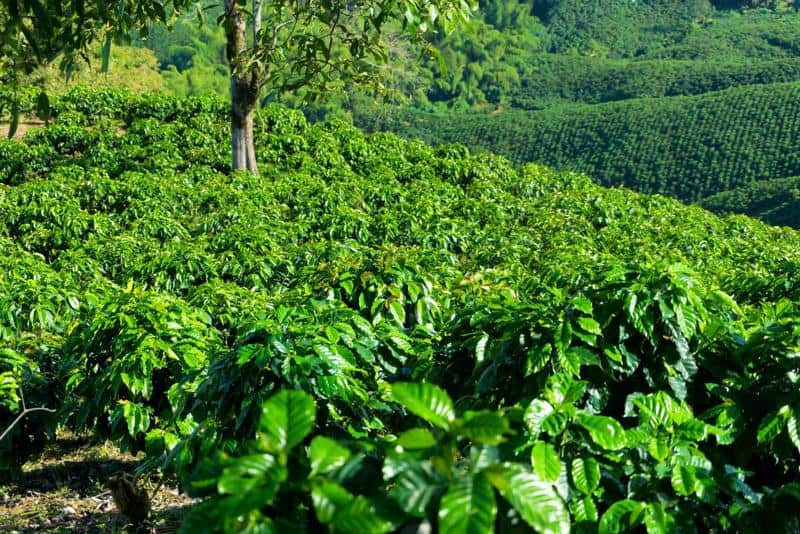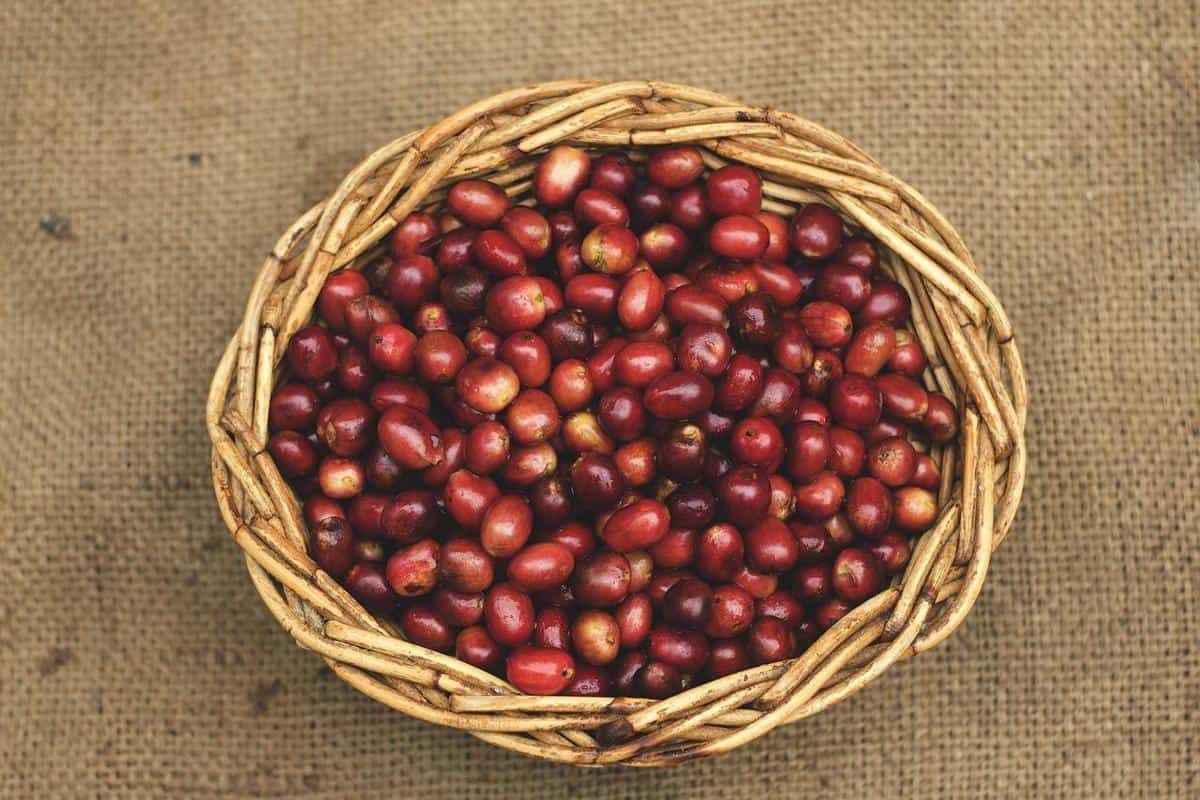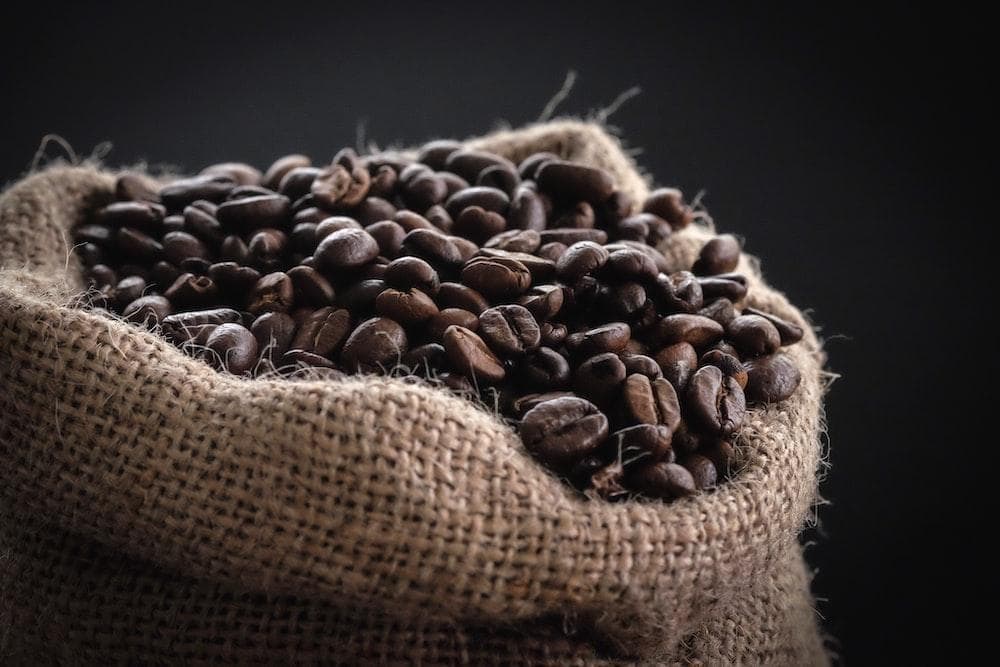Coffee aficionados all over the world can attest to the unique and captivating qualities of Latin American coffee. From its vibrant flavors to its rich history, coffee from this region has charmed palates for centuries. As you embark on a flavorful journey through Latin American coffee, prepare to be mesmerized by the alluring aroma and discover a truly exceptional drink.
Latin America is known as the birthplace of exceptional coffee, with countries such as Colombia, Brazil, and Costa Rica producing some of the finest beans in the world. Each country has its own distinct coffee profile, influenced by factors like climate, altitude, soil composition, and processing techniques. These variations result in a vast range of flavors that cater to different preferences and awaken the senses with every sip.
Colombia, nestled in the enchanting Andean highlands, is renowned for its smooth and balanced Arabica beans. With its ideal growing conditions and meticulous cultivation methods passed down through generations, Colombian coffee offers an experience like no other. On the other hand, Brazil boasts a passionate coffee culture that unites perfection and expertise in every cup. Its bold and full-bodied beans exude richness that resonates with both traditionalists and those seeking new taste adventures.
Central American countries like Costa Rica, Guatemala, and Honduras have their own unique approaches to coffee production. From the mountains to the coasts, these regions offer diverse flavor profiles that showcase the country’s natural beauty. Whether it’s the fruity acidity of Costa Rican beans or the persistent chocolate notes of Guatemalan brews, Central America offers a taste spectrum for exploration.
Join us on this compelling journey through Latin America’s irresistible coffee as we delve into each country’s distinctive offerings. From exploring hidden gem producers to discovering sustainable practices leading the way in ethical production methods – there is much to uncover about Latin American coffee beyond what meets your lips. So grab a cup, inhale the enticing aroma, and let us guide you through this flavorful expedition of a beloved cultural tradition.
The Birthplace of Exceptional Coffee
Latin America is renowned for its exceptional coffee production, with several countries in the region being key players in the global coffee industry. These countries have ideal climates, rich soil, and a long history of coffee cultivation, making Latin America the birthplace of some of the world’s finest coffees.
One of the prominent coffee-producing countries in Latin America is Colombia. Colombian coffee is celebrated worldwide for its high quality and unique flavors. The country’s diverse geography, from the Andean mountains to the fertile valleys and coastal regions, creates distinct growing conditions that contribute to the complexity of Colombian coffee. With a focus on sustainability and meticulous cultivation practices, Colombian farmers have perfected their craft over generations, leading to consistently superior harvests.
Another crucial player in Latin America’s coffee production is Brazil. Being both the largest producer and exporter of coffee globally, Brazil has a significant influence on the international coffee market. The country’s vast plantations stretch across different regions, each offering its own flavor profile. From nutty and chocolatey notes in Arabica beans grown in Minas Gerais to fruity and sweet flavors found in Santos beans from São Paulo, Brazilian coffees encompass a wide range of taste experiences.
Mexico and Guatemala are also prominent contributors to Latin America’s reputation as a top-notch coffee producer. Mexican coffees are known for their mild acidity and balanced flavor profiles, making them highly versatile for various brewing methods or blends. Guatemalan coffees, on the other hand, exhibit more pronounced acidity and distinct fruity undertones due to their high-altitude cultivation in volcanic soils.
Elevate Your Coffee Experience
Latin America is known for producing some of the world’s finest coffee, and exploring the unique flavors of Latin American coffee is a delightful way to elevate your coffee experience. Each country in Latin America has its own distinct flavor profile, making it a fascinating journey for coffee enthusiasts.
One of the key reasons why Latin American coffee stands out is the region’s ideal climate and fertile soil, which provide optimal growing conditions for coffee plants. The high altitudes in countries like Colombia, Costa Rica, and Guatemala contribute to the unique flavors found in their beans. Coffee from these regions often boasts a balanced acidity, floral notes, and vibrant fruity undertones.
Colombia’s renowned coffee is a must-try for any coffee lover. Colombian coffee is known for its smoothness and medium body, with flavors ranging from nutty and caramel-like to bright citrusy notes. The country’s diverse microclimates result in varied flavor profiles across different regions. For example, coffees grown in the Andean Highlands have rich chocolatey notes, while those from the Sierra Nevada de Santa Marta region are characterized by their sweet berry flavors.
Brazil is another prominent player in Latin American coffee production. As one of the largest producers in the world, Brazil offers a range of flavor profiles that cater to various tastes. Brazilian coffee often exhibits low acidity with hints of chocolate and nuttiness. Additionally, Brazil is famous for its pulped natural or honey-processed coffees which highlight its natural sweetness.
Costa Rica, Guatemala, Honduras, Nicaragua, and El Salvador make up Central America’s renowned “Coffee Belt.” Each country within this region showcases its own unique flavor characteristics. Costa Rican coffees are celebrated for their bright acidity with flavors of citrus fruits, while Guatemalan coffees offer complexity with notes of cocoa and honey sweetness.
Exploring the unique flavors of Latin American coffee can be an exciting journey that takes you through a range of taste experiences. From the bright and fruity to the rich and chocolatey, Latin American coffee offers something for every palate. So grab a cup of your favorite Latin American brew and savor the unparalleled flavors that this region has to offer.
A Flavorful Journey through the Andean Highlands
Colombia is renowned for its exceptional coffee, and a journey through the Andean Highlands allows coffee lovers to indulge in the rich flavors and cultural traditions associated with this beloved beverage.
- The Unique Flavor Profile of Colombian Coffee: Colombian coffee is known for its distinct flavor profile, characterized by a medium body, bright acidity, and fruity undertones. The volcanic soil, high altitudes, and perfect weather conditions of the Andean Highlands contribute to the exceptional quality of Colombian coffee beans. The region’s unique microclimates create a variety of flavor profiles, from the citrusy notes found in coffees grown in Huila to the chocolatey undertones of beans harvested in Nariño.
- Exploring Colombia’s Coffee Growing Regions: Colombia’s Andean Highlands are home to several key coffee-growing regions that offer visitors an immersive experience into the country’s coffee culture. In the Quindio region, nestled in the heart of Colombia’s coffee belt, visitors can explore picturesque coffee plantations known as “fincas.” Many fincas offer guided tours where visitors can learn about each step of the coffee production process, from harvesting and processing to roasting and brewing. This hands-on experience provides a deeper appreciation for the hard work and expertise involved in creating a cup of Colombian coffee.
- Embracing Coffee Culture: In addition to tasting world-class coffee, visitors can immerse themselves in Colombia’s vibrant coffee culture. Cafeterias are popular gathering places where locals come together to socialize over a cup of their beloved brew. These traditional establishments often serve tinto, a strong black coffee typically enjoyed throughout the day. Visitors can join Colombians in experiencing this cultural tradition while learning about local customs and practices surrounding this beloved beverage.
Whether you’re traveling through Colombia or enjoying a cup at home, indulging in Colombian coffee offers an unforgettable journey through the flavors and traditions that make it so special. From your first sip, you’ll understand why Colombian coffee has captivated the hearts and taste buds of coffee enthusiasts around the world.
Brazil
Brazil, the largest coffee producer in the world, is known for its passion and perfection when it comes to coffee. With a long history of coffee production and a climate that is conducive to growing beans with excellent flavor profiles, Brazil has earned its reputation as a top player in the global coffee industry.
One of the factors that set Brazilian coffee apart is the country’s dedication to quality at every stage of production. From meticulously selecting the best beans to investing in modern processing methods, Brazil ensures that only the finest coffee reaches consumers’ cups. The country’s vast size also contributes to its success in producing high-quality coffee, as different regions offer unique microclimates that produce distinct flavor profiles.
Brazilian coffee is characterized by its medium body, low acidity, and nutty flavor notes. This profile makes it a versatile choice that can be enjoyed straight or used as a base for blends. The most popular variety of Brazilian coffee is Arabica, which accounts for around 80% of the country’s production. Robusta beans are also grown in Brazil but are primarily used for instant coffees and blends.
In terms of production volume, Brazil dominates the global market. It consistently produces over 50 million bags annually, accounting for about one-third of world production. The Brazilian government has implemented various initiatives to support and promote its coffee industry, including research programs focused on improving cultivation practices and disease prevention.
| Year | Production (in million bags) | Export (in million bags) |
|---|---|---|
| 2020 | 66 | 36 |
| 2019 | 64 | 36 |
| 2018 | 61 | 36 |
It is no wonder that Brazilian coffee has become synonymous with quality and passion. Its rich history, commitment to excellence, and production volume make it an integral part of the Latin American coffee landscape. From its smooth flavor profile to its role in supporting the global coffee market, Brazil truly unites passion and perfection in every cup.
From the Mountains to the Coasts
Central America is a region renowned for its diverse coffee cultures, where each country offers a unique and distinct coffee experience. From the mountainous highlands to the coastal regions, the countries of Central America have long been recognized as major players in the world of coffee production. Let’s take a closer look at the fascinating coffee cultures of Central America.
- Costa Rica: Known for its high-quality Arabica beans, Costa Rican coffee is highly regarded for its bright acidity and vibrant flavors. The country takes pride in its sustainable practices, where many coffee farms have implemented eco-friendly methods to protect their natural resources.
- Guatemala: With a rich volcanic soil and favorable climate conditions, Guatemala produces some of the finest coffees in Central America. The flavors are often described as complex and balanced, with notes of chocolate, fruit, and floral undertones.
- Honduras: As one of the largest coffee producers in Central America, Honduras is known for its diverse range of coffees that cater to varying tastes. Whether you prefer a mild or bold cup of java, Honduran coffee offers something for everyone.
- Nicaragua: Nicaraguan coffee has gained recognition for its smooth body and unique flavor profiles. The shade-grown beans are cultivated under rainforest canopies, resulting in a rich biodiversity that enhances the taste and aroma of the coffee.
To fully appreciate the diversity of Central American coffee cultures, it’s worth exploring these countries individually and immersing yourself in their unique traditions and methods of cultivation. From participating in coffee farm tours to visiting local cafes and enjoying a freshly brewed cup, travelers have an opportunity to witness firsthand how these nations contribute to Latin America’s irresistible coffee scene.
So whether you’re sipping a vibrant Costa Rican brew or indulging in the complexity of Guatemalan coffee, Central America promises an unforgettable journey through its diverse coffee cultures.
Hidden Gems of Latin America
Latin America is well-known for its exceptional coffee, with countries like Colombia and Brazil often stealing the spotlight. However, there are many hidden gems in this region, where lesser-known coffee producers are making their mark on the global coffee scene. These countries may not have the same recognition as their famous counterparts, but they offer unique and delicious flavors that are worth exploring.
One such hidden gem is Peru. Located in the heart of South America, Peru has a long history of coffee production, dating back to the late 18th century. Unlike some of its neighbors, Peru focuses on producing specialty coffee rather than mass production.
The country’s diverse microclimates and high-altitude regions give rise to exquisite flavors and aromas in their beans. Peruvian coffee is known for its medium body, bright acidity, and notes of chocolate, floral tones, and fruity sweetness.
Another lesser-known producer is Honduras. This Central American country has been making significant strides in the world of specialty coffee in recent years. Its fertile soil and ideal growing conditions allow Honduran farmers to produce high-quality Arabica beans with complex flavor profiles. The coffees from Honduras often exhibit notes of tropical fruits like mango and passionfruit, along with caramel sweetness and a balanced acidity.
Ecuador is also making its mark on the industry as a hidden gem in Latin America’s coffee production. Despite being a small country located on the equator line, Ecuador boasts incredibly diverse microclimates that result in distinct flavor profiles for their coffees. From fruit-forward notes to floral aromas, Ecuadorian coffees offer something unique for every palate.
These lesser-known coffee producers are becoming increasingly popular among coffee connoisseurs who are eager to discover new flavors and support smaller-scale producers. By exploring these hidden gems of Latin America’s coffee production, consumers have the opportunity to taste truly remarkable coffees that often go unnoticed.
| Country | Main Coffee Characteristics |
|---|---|
| Peru | Medium body, bright acidity, notes of chocolate, floral tones, and fruity sweetness. |
| Honduras | Tropical fruit notes like mango and passionfruit, caramel sweetness, and balanced acidity. |
| Ecuador | Diverse flavor profiles including fruit-forward notes and floral aromas. |
Sustainable Practices
Latin America’s commitment to sustainable practices in coffee production sets a shining example for the rest of the world. With a focus on ethical and eco-friendly methods, Latin American countries have implemented various initiatives to protect the environment, support local communities, and ensure the long-term viability of their coffee industry.
Environmental Conservation: Preserving Biodiversity
One of the key sustainable practices in Latin American coffee production is environmental conservation. Coffee farms in this region prioritize preserving biodiversity by maintaining shade trees and native vegetation.
These trees not only provide habitat for wildlife but also help prevent soil erosion and conserve water resources. By promoting agroforestry systems that integrate coffee cultivation with other crops or trees, farmers are able to create a more balanced and resilient ecosystem, reducing the need for chemical inputs and enhancing overall ecological sustainability.
Moreover, many coffee producers in Latin America have embraced organic farming practices. They avoid synthetic fertilizers, pesticides, and herbicides, instead relying on natural alternatives like composting, recycling agricultural waste, and using biological pest control methods. This organic approach not only protects the health of soils, plants, and farmers but also safeguards consumers from harmful chemical residues in their cup of joe.
Social Responsibility: Supporting Farmers and Local Communities
Latin American coffee producers recognize the importance of social responsibility as a pillar of sustainable coffee production. They work closely with local communities to ensure fair wages for farmworkers while providing them with safe working conditions. In addition, they invest in education programs and healthcare facilities to improve the quality of life for those living in coffee-growing regions.
Another aspect of social responsibility is fostering economic diversification within farming communities. Some coffee cooperatives or associations help farmers implement alternative income-generating activities such as beekeeping or producing honey, cocoa beans, or tropical fruits alongside coffee cultivation. This not only strengthens their resilience against price fluctuations in the volatile coffee market but also promotes economic stability at the local level.
Certifications and Transparency: Ensuring Consumer Trust
Latin American coffee producers also prioritize transparency and authenticity in their practices. Many farms have obtained certifications such as Fair Trade, Rainforest Alliance, or Organic, which guarantee that strict social, environmental, and economic standards are met during the production process. These certifications provide consumers with the assurance that the coffee they are purchasing has been sourced sustainably and ethically.
In addition to certifications, traceability programs have gained popularity in Latin America’s coffee industry. Through these programs, farmers are able to track each batch of coffee from the farm all the way to the consumer’s cup. This transparency allows consumers to make informed choices and support producers who align with their values of sustainability.
As Latin America leads by example in ethical and eco-friendly coffee production, it demonstrates that a thriving coffee industry can coexist with environmental conservation, social responsibility, and consumer trust. By supporting sustainable practices in Latin American coffee production, we not only get to enjoy a flavorful cup of joe but also contribute to a more resilient and equitable future for both farmers and our planet.
The Art of Coffee Brewing
Latin America is known not only for its exceptional coffee beans but also for the artistry and skill that goes into brewing a perfect cup of coffee. In this section, we will delve deeper into the various traditional and innovative brewing methods that are unique to Latin American coffee cultures.
Traditional Brewing Methods
One of the most iconic brewing methods in Latin America is the “cafetera” or stovetop espresso maker, which is widely used in countries like Cuba and Mexico. This method involves adding finely ground coffee to a chamber at the bottom of the device, then filling the top chamber with water and placing it over a heat source. As water heats up, it creates pressure that forces hot water through the coffee, producing a strong and full-bodied cup of coffee.
Another popular traditional method is the “chorreador,” commonly used in Costa Rica. This method involves placing a cloth or wooden filter on top of a stand, then pouring hot water over freshly ground coffee as it drips into a waiting cup below. The chorreador allows for slow extraction, resulting in a smooth and balanced cup of coffee with rich flavors.
Innovative Brewing Methods
In recent years, Latin America has also seen an emergence of innovative brewing methods that combine traditional techniques with modern technology. One such method is pour-over brewing using equipment like the Chemex or Hario V60. This technique involves pouring hot water over freshly ground coffee placed in a paper filter, allowing for precise control over temperature and extraction time to bring out specific flavor notes.
Another innovative method gaining popularity is cold brew coffee. Cold brew involves steeping coarsely ground coffee in cold water for an extended period, usually overnight. This results in a smooth and less acidic brew that highlights the natural sweetness and subtle flavor nuances of Latin American coffees.
Whether it’s through traditional methods that have been passed down through generations or innovative techniques that push the boundaries of coffee brewing, Latin America celebrates the art and craft of making a perfect cup of coffee. These methods not only showcase the diverse flavors and characteristics present in Latin American beans but also provide coffee enthusiasts with a chance to appreciate the rich history and cultural significance behind each brewing process.
Coffee Tourism
Latin America’s coffee plantations offer a unique and unforgettable experience for coffee enthusiasts. Coffee tourism has become increasingly popular, allowing visitors to embark on expeditions and immerse themselves in the world of coffee production. Latin America, with its rich history and diverse coffee cultures, provides the perfect backdrop for these adventures.
One of the most popular destinations for coffee tourism is Colombia. Known for its high-quality Arabica beans, Colombia offers tours that take visitors through sprawling coffee farms nestled in the vibrant green Andean Highlands. These tours often include activities such as picking ripe coffee cherries, participating in the sorting and processing of beans, and learning about traditional brewing methods. By engaging in hands-on experiences, tourists can gain a deeper understanding of the entire coffee production process.
Brazil is another country that should not be missed by coffee tourists. As the largest producer of coffee in the world, Brazil offers a plethora of opportunities to explore its vast plantations and learn about its unique cultivation techniques. Visitors can witness firsthand the meticulous harvesting and processing methods that contribute to Brazil’s reputation for producing some of the finest coffees globally.
In addition to Colombia and Brazil, Central American countries like Costa Rica, Guatemala, and Honduras also have thriving coffee tourism industries. These countries boast stunning landscapes where visitors can learn about different types of coffee plants, taste various coffees from different regions, and witness sustainable farming practices.
| Destination | Main Attraction |
|---|---|
| Colombia | Touring lush coffee farms in the Andean Highlands and engaging in hands-on experiences. |
| Brazil | Exploring vast plantations with meticulous harvesting and processing methods. |
| Costa Rica, Guatemala, Honduras | Visiting stunning landscapes with diverse coffee cultures and sustainable farming practices. |
Embarking on a coffee tour in Latin America not only allows visitors to indulge in the flavors of the region but also provides an opportunity to learn about the rich cultural and historical significance of coffee production. It is a chance to witness the dedication and passion of the farmers who work tirelessly to create exceptional coffee.
Coffee tourism has become more than just tasting different brews – it is a way to connect with the people, traditions, and landscapes that contribute to Latin America’s irresistible coffee.
Whether you are a seasoned coffee connoisseur or simply enjoy a good cup of joe, embarking on a coffee expedition in Latin America is an experience like no other. The region offers a blend of captivating landscapes, rich history, flavorful aromas, and unique brewing techniques that will captivate your senses.
From exploring sprawling plantations to engaging in hands-on experiences, coffee tourism in Latin America allows you to take part in this ancient tradition while creating lasting memories along the way.
Pairing Perfection
Exploring the Art of Coffee Pairings
Coffee is not only a delightful beverage on its own, but it can also be enhanced when paired with certain foods. In Latin America, where coffee culture runs deep, there are a variety of delicious treats that perfectly complement the flavors of local coffees. By exploring the art of coffee pairings, you can enhance your coffee experience and discover new taste sensations.
One popular pairing in Latin America is coffee with chocolate. The rich, bitter-sweet flavors of chocolate beautifully complement the bold and robust nature of Latin American coffees. Whether it’s a piece of dark chocolate or a luscious chocolate cake, combining it with a cup of coffee creates an indulgent harmony of flavors that will leave your taste buds satisfied.
Furthermore, Latin American pastries and baked goods make for delightful companions to a cup of coffee. Take for example the traditional alfajores from Argentina or the creamy tres leches cake from Mexico. These sweet treats have just the right balance of sweetness and texture to pair harmoniously with the complex flavors found in Latin American coffees.
Matching Regional Delicacies with Local Coffees
One interesting aspect of pairing food with Latin American coffee is that each region has its own unique culinary traditions and specialties that can be matched with their local brews. For instance, in Colombia, where coffee is a way of life, you can enjoy a delicious arepa alongside your cup of Colombian coffee. The savory cornmeal-based arepas go hand-in-hand with the smooth and balanced flavor profile commonly found in Colombian coffees.
In Brazil, where passionate espresso drinkers abound, pão de queijo (cheese bread) is an excellent choice to enjoy alongside your Brazilian brewed coffee. The chewy texture and cheesy flavor of pão de queijo provide an interesting contrast to the strong and nutty notes often found in Brazilian beans.
Exploring New Flavors and Boundaries
While traditional pairings are always a safe bet, it can also be an exciting adventure to explore new flavors and push the boundaries of coffee pairings. Latin America offers a wide variety of exotic fruits, cheeses, spices, and even savory dishes that can provide surprising and delightful flavor combinations when enjoyed with local coffees.
For the adventurous palate, trying a cup of Guatemalan coffee with a slice of fresh mango can create an explosion of sweet and fruity flavors. Or, for those seeking a more unique experience, pairing a Nicaraguan bean with a slice of creamy queso fresco can bring together the subtle hints of sweetness in the coffee with the tanginess of the cheese.
Conclusion
Latin America’s irresistible coffee offers so much more than just a delicious beverage. It takes you on a flavorful journey through the rich history and diverse landscapes of this region. From the birthplace of exceptional coffee in Latin America’s key producing countries, to the hidden gems that contribute to its unique flavors, Latin American coffee is truly a treat for the senses.
Colombia, with its renowned coffee from the Andean Highlands, provides a flavor profile that is deeply indulgent and satisfying. Brazil, on the other hand, brings passion and perfection together in every cup, creating an experience that is both invigorating and comforting. Central American countries offer a range of diverse coffee cultures as their mountains meet their coasts, resulting in an array of fascinating flavor profiles.
While exploring Latin America’s coffee regions, one cannot overlook the hidden gems that may not be as well-known as Colombia or Brazil but still contribute significantly to this region’s vibrant coffee scene. These lesser-known producers add their own unique touch to the flavors of Latin American coffee, making it an even more captivating experience for coffee enthusiasts.
One aspect that sets Latin America apart in the world of coffee production is its commitment to sustainable practices. Leading the way in ethical and eco-friendly production methods, Latin American countries prioritize sustainability by supporting fair trade practices and environmentally friendly initiatives. This dedication to preserving their environment while producing exceptional tasting coffee adds another layer of appreciation for this region’s offerings.
In conclusion, a taste of Latin America’s irresistible coffee takes us on a captivating journey filled with earthy delights and cultural traditions. From the bold flavors found in Colombia’s Andean Highlands to Brazil’s passionate perfectionism and the diverse profiles in Central America, each cup tells a story of this region’s rich history and deep connection with coffee cultivation.
With sustainable practices at its core and a vibrant coffee tourism industry, Latin America truly offers an unparalleled experience for anyone who appreciates both the artistry and enjoyment of coffee.
Frequently Asked Questions
Is coffee popular in Latin America?
Coffee is undeniably popular in Latin America. It has a deeply rooted cultural significance and plays a central role in daily life for many countries in the region.
From Mexico to Argentina, coffee consumption is woven into the fabric of social gatherings, morning routines, and even business meetings. The rich aroma and taste of coffee are cherished by both young and old, making it a beverage that transcends generations in Latin America.
Which Latin American country has the best coffee?
Determining which Latin American country has the “best” coffee is subjective and can be debated among coffee enthusiasts. However, several countries in the region are renowned for their exceptional coffee production and flavors. Colombia, with its ideal geographical conditions for cultivating high-quality Arabica beans, is often considered one of the best coffee-producing countries in Latin America.
Costa Rica is also highly regarded for its specialty coffees, incorporating unique flavors and meticulous processing techniques. Other notable coffee producers in the region include Brazil, Guatemala, and Honduras.
Why is coffee so big in Latin America?
Coffee holds such prominence in Latin America due to a combination of historical, geographical, and cultural factors. Many countries in the region possess favorable environmental conditions such as suitable climates, altitudes, and fertile soils that are conducive to growing top-quality coffee beans.
Additionally, the long-standing tradition of coffee cultivation dates back centuries to when European colonizers brought coffee plants to the New World. The economic importance of coffee production has shaped Latin American nations’ identities over time and continues to contribute significantly to their economies.
What are the flavors of Latin American coffee?
The flavors of Latin American coffee vary depending on factors like origin, altitude, soil composition, processing techniques, and roasting methods employed by farmers or producers. Colombian coffee often exhibits notes of caramel sweetness with hints of citrus acidity and chocolate undertones. Costa Rican coffees tend to be bright with fruity or floral flavors accompanied by a crisp acidity that balances well with its sweetness.
Brazilian coffees can offer nutty or chocolatey profiles with low acidity levels due to their natural and pulped natural processing methods. Other Latin American coffees, such as those from Guatemala or Honduras, can showcase a wide variety of flavor profiles ranging from fruity and vibrant to nutty and chocolatey.
What is the #1 coffee drinking country?
The title of the number one coffee-drinking country depends on how consumption is measured. However, in terms of per capita coffee consumption, Finland often holds the top spot globally. Finns are known for their deep appreciation of coffee, consuming an average of over 12 kilograms per person annually.
Scandinavian countries like Norway and Iceland also rank high in terms of per capita coffee consumption. Nonetheless, it’s essential to note that while Latin American countries might not dominate the rankings for individual consumption, they play a pivotal role as major coffee producers that supply much of the world’s demand for this beloved beverage.

